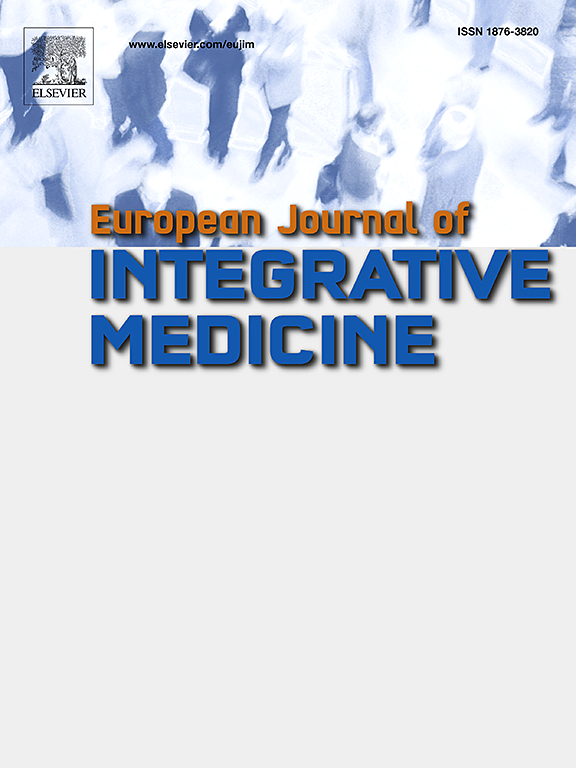访问加纳何两家医院的成年人对草药和传统药物的偏好和使用以及剂型偏好:一项横断面调查
IF 1.7
4区 医学
Q3 INTEGRATIVE & COMPLEMENTARY MEDICINE
引用次数: 0
摘要
必须了解患者对治疗方法的使用和偏好,以指导政策制定和改善医疗保健。此外,向患者提供药物的剂型可以影响治疗的依从性。因此,在本研究中,我们调查了成人对草药和传统药物的偏好,两种药物类型的使用情况,以及口服和外用制剂的期望。方法采用横断面研究方法,对加纳何市何市立医院和何教学医院门诊的430名调查对象进行调查。参与者有目的地抽样完成一份调查问卷,然后对数据进行分析。结果78.8%的参与者更倾向于传统医学。治疗偏好受年龄(p = 0.033)和文化程度(p = 0.013)的影响。选择两种治疗方法的主要原因是感知有效性(55.8%,正统;14.4%,草药)和安全性(60.0%,正统;9.5%,草药)。非处方药使用(中草药/正统)主要是由于自我药疗(11.6%)、广播/电视广告(12.6%)和非专业建议(36.5%)。首选口服制剂为片剂(54.9%)、胶囊(54.0%)和液体(44.9%);年轻和年长的参与者分别更喜欢液体和胶囊。文化程度影响胶囊偏好(p = 0.039)。收入水平与胶囊(p < 0.00001)、液体(p = 0.012)和粉末(p < 0.00001)显著相关。软膏(61.2%)、乳膏(56.3%)和凝胶(25.3%)是首选外用产品,其偏好受收入、教育程度和宗教信仰的显著影响。结论患者对中药的偏好高于中药,对常规口服和外用剂型的偏好高于中药。还观察到一些与会者滥用药物,这表明需要控制媒体中的药物信息并加强关于药物安全的公众教育。本文章由计算机程序翻译,如有差异,请以英文原文为准。
Preference and usage of herbal and orthodox medicines and dosage form preferences among adults visiting two hospitals in Ho, Ghana: a cross-sectional survey
Introduction
The usage and preferences of treatments among patients must be understood to guide policy development and improve healthcare. Additionally, the dosage form in which a medicine is presented to a patient can influence compliance with therapy. Therefore, in this study, we investigated the preference of herbal medicine versus orthodox medicine, usage of the two medicine types, and desired oral and topical formulations among adults.
Methods
A cross-sectional study was conducted among 430 respondents at the outpatient departments of Ho Municipal Hospital and Ho Teaching Hospital in the Ho municipality of Ghana. Participants were purposively sampled to complete a questionnaire, after which the data were analyzed.
Results
Participants mostly preferred orthodox medicine (78.8 %). Treatment preference was influenced by age (p = 0.033) and educational level (p = 0.013). Key reasons for preferring either treatment were perceived effectiveness (55.8 %, orthodox; 14.4 %, herbal) and safety (60.0 %, orthodox; 9.5 %, herbal). Unprescribed medicine usage (herbal/orthodox) was attributed to self-medication (11.6 %), radio/TV adverts (12.6 %), and non-professional advice (36.5 %). Tablets (54.9 %), capsules (54.0 %), and liquids (44.9 %) were the preferred oral formulations; younger and older participants largely preferred liquids and capsules, respectively. Educational level influenced capsule preference (p = 0.039). Income level showed significant associations with capsules (p < 0.00001), liquids (p = 0.012), and powders (p < 0.00001). Ointments (61.2 %), creams (56.3 %), and gels (25.3 %) were the preferred topical products, with preferences significantly affected by income, education, and religion.
Conclusion
Our findings indicate a higher preference for orthodox medicine over herbal medicine as well as preference for conventional oral and topical dosage forms. Indiscriminate medicine usage by some participants was also observed, indicating that control of medicine information in the media and enhanced public education on medicine safety are needed.
求助全文
通过发布文献求助,成功后即可免费获取论文全文。
去求助
来源期刊

European Journal of Integrative Medicine
INTEGRATIVE & COMPLEMENTARY MEDICINE-
CiteScore
4.70
自引率
4.00%
发文量
102
审稿时长
33 days
期刊介绍:
The European Journal of Integrative Medicine (EuJIM) considers manuscripts from a wide range of complementary and integrative health care disciplines, with a particular focus on whole systems approaches, public health, self management and traditional medical systems. The journal strives to connect conventional medicine and evidence based complementary medicine. We encourage submissions reporting research with relevance for integrative clinical practice and interprofessional education.
EuJIM aims to be of interest to both conventional and integrative audiences, including healthcare practitioners, researchers, health care organisations, educationalists, and all those who seek objective and critical information on integrative medicine. To achieve this aim EuJIM provides an innovative international and interdisciplinary platform linking researchers and clinicians.
The journal focuses primarily on original research articles including systematic reviews, randomized controlled trials, other clinical studies, qualitative, observational and epidemiological studies. In addition we welcome short reviews, opinion articles and contributions relating to health services and policy, health economics and psychology.
 求助内容:
求助内容: 应助结果提醒方式:
应助结果提醒方式:


